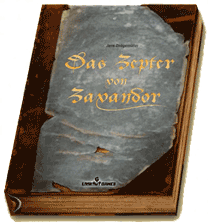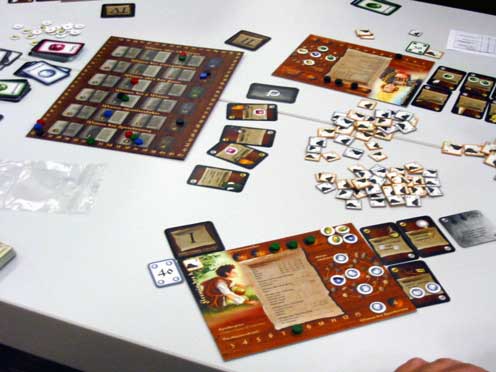
Gamers who’ve been around for a while will know of the legendary Outpost. This science fiction-based logistics game was published in 1991 by TimJim Games and has been out of print for nearly as long. You see dog-eared copies of the game still being played avidly at games conventions. And collectors will pay large sums for any secondhand copies that come up for sale. But now we have Das Zepter von Zavandor (Zavandor’s Sceptre) from Lookout Games (a German publisher, despite the name). The credits explicitly thank Outpost designer Jim Hlavarti for permission to use the mechanisms from his game. From my hazy memories of Outpost (it’s been a few years), Das Zepter von Zavandor is much the same game. Albeit translated to a fantasy theme by designer Jens Drögemüller. More experienced Outpost players tell me that Zepter plays as a rather different game, while the rules remain broadly similar. Be that as it may, the result is a terrific game, which I find quite addictive. The problem with writing a review is that it’s quite a complex game. I have the usual reviewer’s dilemma – of explaining enough of the game to get the flavour across without reproducing the rules – in spades. Still, let’s give it a go. The story of the game is that the players are students of magic competing to win Zavandor’s sceptre by having the most magical power and knowledge. For which read “having the most victory points”. Points are scored for various things players build up through the game. The most valuable items are mainly the various ‘sentinels’, which provide large bonuses (like the ‘large buildings’ in Puerto Rico). They also end the game, since everything is wrapped up once five or more sentinels have been acquired. Like everything else in the game, sentinels must be paid for in magical energy. And they cost a lot of it. Thus the overall strategy of the game is to build up the amount of magical energy you generate to the point where you can afford a sentinel or two. (Three is just greedy!) Players get their magical energy from gems, which must be ‘enchanted’ by spending magical energy. So each turn you get a bit more magical energy, which you invest in victory points and in getting more magical energy for next turn. There are five kinds of gem in the game. Opals are the ‘cheapest’ for players to enchant, but produce the least magical energy and are worth few victory points. The cost, the yield and the victory points get bigger through Sapphires, Emeralds and Diamonds to Rubies. Players can only have a limited number of ‘active’ gems, which actually produce energy, so getting better gems is one way to produce more energy. However, players have to have the right artefact or knowledge before they can use the three better gems. Having more active gems is the other way of generating more income and, again, artefacts and a field of knowledge allow players to do this. To complicate things further, magical energy comes in three forms. The first of these is ‘Magic Dust’. It’s generated by Opals and is what you get if you need change. It comes in 3 denominations and can be changed at any time. The other four gems produce energy in the form of cards – 1 for each gem you have. The value of the cards varies around an average, which is bigger, the better the gem. However, if a player has four of the same gem, they get a ‘concentrated energy’ card instead of four individual cards. These have the value of four average cards, but players also get 2 points in Magic Dust with each one. So a set of four gems will, on average, generate slightly more energy than four individual gems. The amount of energy players can hold from one turn to another is strictly limited, depending on the form it’s held in. Concentrated energy cards count 3 to the limit, while individual cards cost 1 – naturally – and Magic Dust varies according to the denominations it’s held in. The effect is that concentrated energy cards are the most efficient way of holding energy, while Magic Dust is the least efficient. Again, the right magical artefacts or knowledge can change this. Managing your magical energy is an important part of the game. The magical artefacts do all sorts of things: allowing players to enchant better gems, improving their position in a field of knowledge and more. In general, they boost the owner’s position and, occasionally, damage others’ positions. They are gained in auctions. One player puts an artefact up for auction and everybody can bid for it – in energy of course. If the player who started the auction doesn’t get the artefact, s/he can auction another. One tactical note here is that the player who goes last in the turn can usually auction an artefact and get it at face value since everybody else will have spent their energy. The deck of artefact cards is carefully organised so that the cards gradually increase in cost (there’s a minimum bid), power and victory point value. Another important part of the game is deciding which artefacts to buy and when. As there’s only a limited number of each artefact, the bids can escalate rapidly if several players want the same thing. This brings us to the six fields of magical knowledge. These are shown on a small board that is the central component of the game. Players place markers to show the level they’ve achieved in each field and get victory points for achieving ‘mastery’ – the top level. There’s a large cost – in magical energy, of course – to starting a new field, while the cost of improving starts low and gets more expensive. Again, each field of knowledge gives players an advantage. For example, “knowledge of gems” provides a discount on enchanting new gems. The better the knowledge, the bigger the discount. Strategy (and tactics) in the game is mainly about the fields of knowledge and artefacts. Probably the most extreme example of this is the Ruby strategy. Rubies provide the most energy, so being able to enchant them is obviously a good idea. The only way to be able to do this is to achieve mastery of the ‘Fire’ field of knowledge. So first you have to go up the levels of this field, which takes turns and costs energy. Once you have the ability to enchant Rubies, you then need to spend energy to do so – and Rubies are expensive. So you need to be generating energy before you get any Rubies. Hence, your tactics need to be a balance between generating more energy in the short term and advancing your ultimate strategy. In practice, going for Rubies will produce a lot of energy towards the end of the game. But anyone following this strategy will have suffered in the early turns and will be significantly behind the other players. Whether they catch up depends on how quickly the game finishes. 
The last element of the game is the set of characters: each player takes one at the start. This gives them an initial level in a specific field of knowledge and a certain amount of magical energy. Physically, it’s a board with spaces for the player’s various markers and gems and a table that summarises the benefits of the different fields of knowledge. In game terms, it gives each player a head start in a particular strategy. Draw the Druid as your character and you start with knowledge of Fire, making it cheaper and quicker to go for the Ruby strategy. Phew! Let me step back from the mechanics of the game and talk about how it plays. The main point is that you are always trying to expand. This means buying better gems, buying artefacts and improving knowledge. At the start of the game you don’t have enough energy to do all of these, so there are decisions to be made. The balance is between immediate returns and development for the future. Later on, you have much more energy, but it’s still a question of seeing what you can afford. With discounts and surcharges from knowledge, artefacts and players’ positions in the turn order, this can mean doing a few sums. Other players may force the pace. Say you’re building up your energy production to buy a particular artefact. Then someone else puts it up for auction. Either you’re going to miss out (though there are at least two of each artefact) or you’ll have to forego more energy production to get the artefact. When the end game arrives and players are buying sentinels, the same applies. The first player to put one up for auction can spark a stampede as everyone sees the end of the game in sight. An interesting tactical point that I keep forgetting is that players can dis-enchant their gems to produce energy. This can be a useful way of augmenting the energy on hand, but does mean they are trading victory points for energy. I have to say that I have not mastered this game yet. I can usually stay in contention through the game, but then lose out on the final sprint. However, I find it a very enjoyable game. Most of the time, players work on their own, following their own strategy. The auctions provide the main way of interfering with others’ plans. As always, though, the path to success seems to be doing something different from the other players. The production of the game is good with nice, solid components. This is marred by a few typos, but a second printing is planned, which should iron these out. The game was only available in German originally (though the addition of a crib sheet for each player made it eminently playable by non-German speakers), but an English language edition, The Scepter of Zavandor, is now available. Highly recommended. Das Zepter von Zavandor was designed by Jens
Drögemüller and is published by Lookout Games (and by Z-Man Games in the USA as The Scepter of Zavandor). It is a complex
strategy game for 2-6 players aged 10+ that takes 2½-3 hours to play (with
four). It is available in specialist games shops in the UK.
| Pevans |